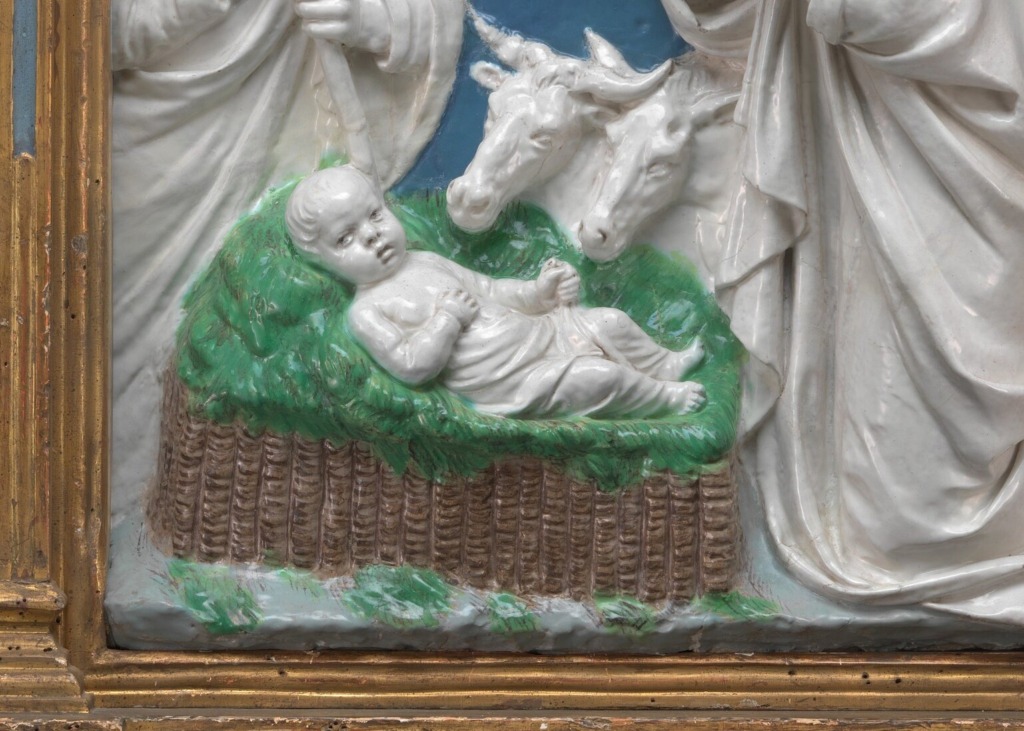“Only when Christ is formed in us will the mystery of Christmas be fulfilled in us. Christmas is the mystery of this ‘marvelous exchange’: ‘O marvelous exchange! Man’s Creator has become man, born of the Virgin. We have been made sharers in the divinity of Christ who humbled himself to share our humanity.'”
These words from the Catechism of the Catholic Church (No. 526) invite us into the mystery of the Incarnation that the Church celebrates in the Christmas season.
An exquisite framed glazed terracotta sculpture titled “The Nativity” by the renowned Italian Renaissance master artist, Luca della Robbia, invites us to humble ourselves before the great mystery of God sharing in our humanity.
We join with Mary and Joseph, the angels and the animals in the stable of Bethlehem in their awe and wonder at this marvelous exchange between God and humanity. And we sing praise for the gift of our sharing in the divinity of God who humbled himself to share in our humanity.
Groundbreaking art
Painted terracotta sculptures like this treasured work by Luca della Robbia were the creation of three generations of a family of artists whose work was groundbreaking in their day. Their signature large white relief figures were set against a sky-blue background framed by garlands of fruit, flowers and animals in vibrant hues of green and yellow.
Luca della Robbia (1399/1400-1482) was a true Renaissance innovator who breathed life into clay by mixing baked terracotta with painting and glaze recipes for one-of-a-kind, expressive and long-lasting sculptures.
Family and art came together in the della Robbia workshop as Luca handed on his innovative techniques to his nephew, Andrea della Robbia, who passed on the valued skills to his sons Giovanni, Girolamo and Luca the Younger.
Even as their remarkable creations began to be admired widely and demand increased across Europe, the della Robbia artistic techniques remained a closely guarded family secret, along with the family owned clay bed near the Arno River in Florence.
No signatures were needed on della Robbia creations because no other Renaissance artist succeeded in imitating their stunning success.
Glory to God in the Highest
In this masterpiece from the National Gallery of Art in Washington, we see Mary and Joseph kneeling before the newborn Jesus, their eyes fixed in contemplation on the face of God revealed in their newborn son.
Mary’s face, full of grace, radiates light as she folds her hands in prayerful adoration before Jesus, her divine son. On the left, St. Joseph leans on his staff as he ponders the mystery of Mary’s motherhood and the divine child he will name Jesus and serve as foster father and guardian.
Both figures are clothed in delicately folded robes that give a remarkable sense of depth to the scene. One can almost sense the warm breath of the two animals standing closely over the cradle of the child Jesus.
Luca della Robbia places the newborn Jesus as the figure closest to viewers. Nestled in a bed of green grass in a raised basket, the Christ Child is a lively, robust baby whose eyes look out to hold our gaze. Taking our place in the stable of Bethlehem, we contemplate the face of the incarnate God through the eyes of his mother Mary and his foster father, Joseph.
Above the figures of Mary and Joseph, a host of angels look down from a heavenly space marked out by a layer of sculpted blue clouds. The words of the angel’s hymn of praise, etched in gold into the frame above, resound in Latin: “Gloria in Excelsis Deo.”
The artist invites us to encounter the newborn Jesus and join with full voice, mind and heart in the Church’s hymn of Christmas praise to sing: Glory to God in the highest!
Sullivan teaches catechetics at The Catholic University of America in Washington. She is the author of “The Beauty of Faith: Using Christian Art to Spread the Good News.”

